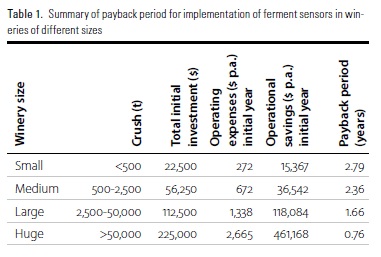Development and application of process analytical technologies for effective winemaking process control
Project summary
Commercial winemaking operations devote significant resources to ferment management. Current management practices involve sampling and analysis requirements across the vintage period. This typically includes daily monitoring of Baume levels and subsequent testing and/ or tasting of samples. In-line sensors offer an opportunity for the wine industry to reduce labour and analysis costs and exert greater control of ferments, by having immediate access to more ferment data. They also offer the potential to reduce the frequency and impact of slow or stuck ferments. This should result in improved product consistency, better resource use, greater throughput, reduced risk of quality downgrades and lower costs. This project assessed the suitability of commercially available sensors for use in monitoring wine fermentations.
Latest information
Technology review and vintage trials
A review was conducted to identify viable commercial sensors with the greatest potential for application in wine fermentations. Four sensor technologies were chosen to be tested in field trials during vintage 2015:
- Liquiphant vibrating fork (Endress & Hauser)
- Fermetrol probe (Psitec)
- Micro-LDS sensor (Integrated Sensing Systems, US)
- VS-3000 (VitalSensors Technologies, US).
The field trials were carried out at Petaluma Wines (Adelaide Hills, SA) and De Bortoli Wines (Riverina, NSW). At Petaluma, three sensors were located in a 6.5 kL fermenter used for white fermentations. At De Bortoli, four sensors were mounted in a bypass loop configuration on a 200 kL tank used for red fermentations.
A number of technical challenges were encountered in the red ferment trial, with the presence of ferment solids seriously affecting measurement for some of the sensor technologies. These issues meant that quantifiable data could not be collected from the red ferment trial. The white ferment trial was more successful, with the three sensors (Liquiphant, Fermetrol and Micro-LDS) able to be assessed across a number of ferments. Based on that trial, the micro-LDS sensor was deemed to be the most effective, although all three sensors exhibited process-related issues that may hinder their implementation on a broader scale across the industry.
The attempted trial at De Bortoli highlighted that the red fermentation medium is much more challenging to monitor and that additional process integration considerations will be required. Even with the cleaner white fermentation media, processing steps, such as the addition of bentonite, can impact on sensor performance and need to be taken into account.
Cost-benefit analysis

A cost-benefit analysis (Table 1) was carried out to identify the potential payback period for wineries of different sizes considering investment in this type of technology. This analysis was based on assumptions that one of the selected ferment sensor technologies could be successfully implemented into the fermentation process and potential technical barriers could be addressed. Operating expenses included power requirements for the sensors and maintenance (cleaning) costs after each ferment. For the purposes of financial modelling, the cost of each sensor was set at $2,000, with auxiliary costs of $250 per sensor. All three sensor technologies that were formally rated through 2015 vintage trials are available commercially at around this price. Operational savings were calculated to include reduced analytical costs, reduced frequency of tank sampling and reduced impact of problematic ferments on must or wine quality.
The analysis shows that the payback period for wineries reduces as the winery size increases, primarily due to the overall impact on reducing wine/must quality downgrades by minimising the impact of problematic ferments. Initial capital expenditure outlay, including auxiliary equipment (piping connections, communications wiring etc.) for the very large wineries is, however, significant. The time and effort required to undertake installation and commissioning of these sensor technologies should not be underestimated, especially where there is a requirement for capture, conversion, communication and storage of raw output data from the sensors and potential integration of this with existing process control systems.
Project Team
Eric Wilkes
Neil Scrimgeour
Peter Godden

